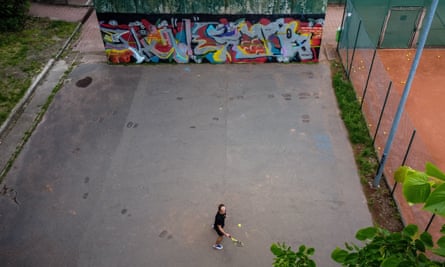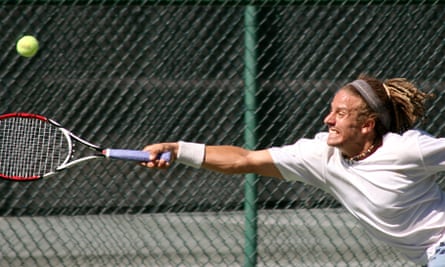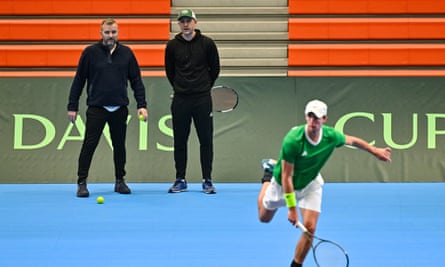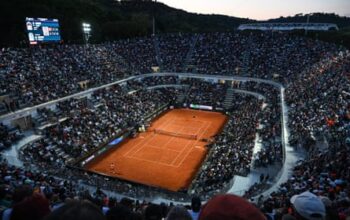I was 10 when I first told my folks that I wanted to give up playing tennis. They didn’t yield then, and they never did. Tennis was our family business. I first picked up a racket at the age of three, and spent 15 years of my life travelling the world in pursuit of entry into major tournaments.
I spent all of September 2005 – including my 24th birthday – alone in Switzerland, playing four week-long tournaments back to back. After 20 matches and with two trophies under my belt, I was ready for a rest. But I had already entered a tournament in Edinburgh – not knowing Switzerland would be quite so intense – for my ninth tournament in 10 weeks.
I phoned Mum from the airport in Geneva, telling her I was tired and would skip Edinburgh and fly home instead. She wasn’t having that. “This is your job now, Conor,” she said. “You can’t just not turn up because you’re tired.” I remembered my friend and one-time tennis partner Pat Briaud’s words: “Your parents don’t mess around.” I turned up and made the semi-final, losing a feisty two-and-a-half-hour match to Britain’s Jamie Baker. It was my 24th match in five weeks. Exhausted, I collected my prize money: $480, before 20% tax.
This is your job now, Conor.
There are three tiers in the hierarchy of men’s professional tennis. The ATP Tour is the sport’s top division, the preserve of the top 100 male tennis players in the world. The Challenger Tour is populated mainly by players ranked between 100 and 300 in the world. Below that is the Futures tour, tennis’s vast netherworld of more than 2,000 true prospects and hopeless dreamers.
I wasn’t schlepping my way through the lower ranks of the professional tour for the money or the prestige, both of which were in short supply. I, like everyone else, was there to remove myself from the clutches of the lower tiers. The Futures tour sometimes felt like a circle of hell, but in practical terms it’s better understood as purgatory: a liminal space that exists only to be got out of as quickly as possible.
I had my first closeup of the big time when the main ATP event rolled into San Jose, California for a week while I was a student at Berkeley. I was allowed to sit in the players’ lounge despite the fact that I was not a competitor. Our team had been brought down to the event by our coaches and given access-all-areas passes, with a view to soaking up the atmosphere and gaining inspiration.
All ATP tournaments need big names to draw crowds and media interest, and the top players can make seven figures simply for showing up for the first round. In San Jose, Andre Agassi was the big name. I was sitting in the players’ lounge when I looked up to see him walk past, surrounded by a gaggle of tournament organisers. I felt a surge of adrenaline seeing him up close for the first time. Some things about him were familiar – his brisk walk, pigeon-toed stance and rounded shoulders, as though permanently setting himself to return serve. Some others were unfamiliar. I’d never noticed his vacant gaze before, which was presumably the product of a long-practised avoidance of eyes staring at him.
“Can we get you anything, Andre?” the gaggle circling him asked earnestly. “Uh, sure, I’ll have some water,” he replied half-heartedly, even though he was standing a few paces from a fridge full of bottled water. He wanted to give them something to do. One of them was dispatched and quickly came back with a plastic glass full of chilled water. Andre took a small sip and put it down on the table beside him, the one I was sitting at. He didn’t pick it back up. After a few moments, Andre and his entourage moved on.
I couldn’t stop staring at the glass of water he had left behind, and considering what it represented. I stared at the smudges left in the condensation by his fingers, and then watched the water marks slowly bleed out to the bottom of the glass. Agassi later wrote in his autobiography of how lonely he found tennis. I understood what he meant, of course – I found it lonely, too. But remembering the sight of him besieged by help in San Jose, I think I’d have preferred his kind of loneliness.
All serious tennis players – from gods such as Agassi to college players like I was at the time – have to grapple with isolation. For people who are comfortable with it, pro tennis can be a refuge: they find it behind a hotel door, with headphones on in a far-flung airport and, above all, inside the white lines of the court. The downside is that the victories are often private, too. When you remove the headphones, there is probably no one around to talk to; and even if there is, you probably don’t speak the same language. We were a strange cohort: sharing courts, canteens and coaches around the world but remaining ultimately alone.
The greats in tennis often become known by their first names – Roger, Rafa, Serena – but the rest of us are known by a number, our world ranking. To a greater extent than in any other sport, world ranking determines who you play, where you play and how much money you make. Tennis players have a deep and lasting relationship with their highest ranking. (Mine was 129.)
Your ranking determined your social status on tour. The guy ranked at number 90 in the world doesn’t get as warm a handshake from the Slam champion as the guy ranked at 20. The Williams sisters didn’t linger to have a chat with me when Serena and I were 16-year-olds training at the Bollettieri tennis academy in Florida, but a girl I hit with who was ranked 50 in the world did stop and talk. Where a player sits in the hierarchy determines how they act, and everyone knows it.

At a later Challenger event in Marburg, Germany, a then 18-year-old Grigor Dimitrov was new to the men’s tour and latched on to me before the delayed arrival of his coach. He knew that I was also travelling alone, and he rang my hotel room a few times. “Hey, wanna grab a pizza?” He was cocky, but friendly, and he knew he needed to earn his stripes at the Challengers. I liked him. He had won Junior Wimbledon and US Open Juniors the year before, and did not know many of the senior players.
“I like watches and speak English perfect,” he told me with a huge grin. I chose not to correct him, remembering my Bulgarian was sketchy. He also confided, even more proudly, that “Sharapova likes me, man”.
We practised together for the week. “Hey,” he shouted to me across the court during one hit, his eyes smiling. He went into an impression of my stiff-looking walk, then picked up two balls and did an impression of my serve. It was very accurate. And funny. Professional tennis players are usually very good physical mimics. It’s how they got good in the first place, by copying what they saw on TV and processing physical cues from their opponents. And Dimitrov, a world-class talent, was really good at it. They called him “Baby Fed”, because his style was nearly identical to Federer’s. I laughed back to him across the court, but suddenly felt my age.
Several years later, I watched Maria Sharapova, now officially his girlfriend, cheering him on courtside at Wimbledon. I bumped into him occasionally, but his greeting to me became less and less effusive as his ranking climbed higher.
By the time he had cracked the top 20, he was ignoring me completely.
If Andre Agassi was lonely but never alone, players on the Futures tour are both. Whereas the top 100 repeatedly come across each other at the same events every year, there is nowhere near the same level of consistency in the lower ranks. There are one or two Tour events staged every week across the world for the top guys, but roughly four or five Challenger events a week, and between 10 and 12 Futures events. The usual message of farewell among players is, “See you somewhere.”
The loneliness of my early years on the Futures tour could be crushing, and it made the time spent not playing tennis more difficult than the tennis itself. You need to conserve energy, and I was obsessed with recovering by staying off my feet. My body invariably ached after a three-set match, so I had to become an expert at passing time. I almost never went sightseeing on a day off. That was partly to conserve energy, partly because I had nobody to go with. And in many of the one-horse towns that hosted Futures events, there weren’t any sights to see.
Some players did go out partying locally, which I always felt was a stupid thing to do. Why put yourself through the budget travel, practice and expense to then go drinking in some remote and isolated corner of the world? Drinking obviously inhibited performance but, apart from that, there was rarely anywhere interesting to go in the vicinity of a Futures event. There were, I’m pretty sure, no good boozers around the Smash Tennis Academy in Cairo.
I staved off the boredom of competing on the fringes of Europe and Asia by sleeping in as late as I could, to limit the number of dull, conscious hours. I often spent entire afternoons and evenings subjecting myself to endless loops of BBC news, punctuated only by the refrain for India’s tourism campaign – Incredible India! – and the BBC’s Lyse Doucet’s peculiar accent. I learned more about Middle Eastern conflicts from her than I wanted to. These were the sounds of my afternoons and evenings. I caught myself occasionally referring to the hotel as “home” when waiting for the tournament shuttle bus to take me back from the courts. And I would return to Ireland from three-week trips to these exotic places with no notable stories or experiences. “How was Morocco?” I would be asked. “Fine,” I would say, with nothing else to add.

While boredom on tour is guaranteed, its extent can vary. Match schedules are painfully vague: a typical Order of Play could read “Sixth match after 10am”, and maybe, if you were lucky, it would be further narrowed to “not before 3pm”. So you could be playing any time from 3pm to 9pm, depending on the length of the matches in front of you. Eoin Reddan once expressed his horror to me at this “schedule”. Eoin, as an Irish rugby international, had his day arranged for him with military precision: he knew where he would be and how long he would be there for every minute of a match day. Tennis players, by contrast, just have to wait around for the call. And be ready.
The truly elite players are not subjected as much to the uncertainty of the Order of Play. The British player Dan Evans once spent three weeks practising with Roger Federer in Dubai, as part of their respective pre-seasons. They played a three-set match every day for 21 days. Federer insisted on starting each practice match at seven in the evening. Why? Three weeks out, he already knew he would play his first match at 7pm on the Tuesday in the Doha ATP event. Can we get you anything, Andre?
At Futures level, worse than the uncertainty of today is that of tomorrow. You never know when you’re going to lose, and so you don’t know when you’ll need to fly off to the next event. My early years on tour were pre-smartphone, so you always knew where to find the players who’d lost that day: sweaty and still in their kit, they would be lined up to use the PC in the hotel lobby, booking flights home, or else on their way to the airport en route to their next event. Surviving on the Futures and Challenger tournaments isn’t just about being good at tennis. It’s about being able to cope with the strange bedfellows of regular boredom and constant uncertainty. Not many succeed.
Locker rooms on the lesser tours are full of strangers with bad tattoos. Everyone is just polite enough not to call one another out for being an asshole, but selfishness is rewarded. Everyone is in competition with one another and on the lookout for a weakness in everybody else, and players never go out of their way to make the life of a lone traveller any easier.
I was as bad as the other players when it came to not reaching out. Once you get burned by a player blanking you, you don’t try again. The ego is too precious. Best to strut on by. The best players on tour are usually considered the friendliest, as everyone wants to say hello to them, and they will usually say hello back.
Tennis is an individual sport, of course, but players often need each other, more so at the lower level when they don’t have hitters and coaches travelling with them for practice. The general rule on tour is the higher up the rankings you go, the easier it is to find a practice partner for the few days before a tournament. The elite end of the sport is more of a fixed society, so players are generally more open to helping out fellow players they will run into again. But at the crowded lower levels, you can take a punt on the prospect of never seeing a certain player ever again.
Ask for a practice hit at the Futures level and the response – with the player already looking past you – was often, “No, I already practised.” At the top Challengers and ATP events, the response would often be along the lines of, “No, I already have a hit scheduled for three, but I can do tomorrow at 10am?”
Asking players to hit was awkward, but necessary. It’s impossible to start a match well without at least a 30-minute hit earlier in the day, preferably an hour or two beforehand. It’s not just a physical thing. I could go for a run to get a sweat on, but you need to feel the ball, to build up ball-striking rhythm, play practice points. When it’s 0-0 and you’re staring down a serve of up to 130mph, it’s too late to start warming up.
Seeking a warm-up partner, I would have to approach players I had never met before, trying not to come across as too desperate. I once opened with, “I’m good, I promise” – admittedly sounding quite desperate. Failing that, I would write “Conor Niland + looking” when signing up for a practice court in the referee’s office and hope someone would write their name beside mine. When I travelled alone, I often went to bed worrying whether I’d find someone to warm me up ahead of the next day’s match. One huge advantage of travelling with a coach was that it allowed you to avoid that stress.

My older sister Gina turned professional after she finished school. When she was 18, the Irish national broadcaster RTÉ made a TV documentary about her, in which she was filmed warming up for the final of her Futures event in Algeria by hitting a ball against a wall. By finals day, almost everyone had gone home, and evidently none of the camera crew hit it well enough. Cut to 15 years later in Switzerland. I’ve qualified for my first-ever pro circuit final and I’m warming up alone, hitting a ball against a wall.
When I made the last eight of a Futures event in the UK in 2005, the only other player in the quarter-finals who lacked a warm-up partner was Jamie Baker, so it made sense that we’d hit together. But he told me he’d prefer to warm up with his 60-year-old coach, as he had been doing it all week. I was left as the odd one out. Andy Murray’s brother, Jamie, on site for a doubles match, came to my rescue and warmed me up after he finished his doubles warm-up preparations.
I made virtually no lasting friendships on tour through my seven years, despite coming across hundreds of players my own age living the same life as my own. Those destined for greatness, the teenagers who join having won grand slams on the junior circuit, don’t hang around the Futures for long: they win four or five events and then jump right to the Challenger Tour in less than a year, often while still a junior. They are in the minority, however, and the Futures tour housed some eccentric souls.
American John Valenti, who went by Johnny Blaze, spent more than a decade on tour without ever earning an ATP singles ranking point, consistently losing in the true obscurity of the first round of Futures qualifying rounds. He wore dreadlocks and a T-shirt bearing the message “GRINDER”, and lived in a converted school bus. His worldview was expressed in a video he uploaded to YouTube. “I am going to fight the talent you gave me, God,” he tells the camera. “I am going to fight my natural hand-to-eye coordination, no matter how bad it is, I am going to hit all of these motherfucking balls until I develop a shot. I am going to do this for months and months and months: I am not going to let these rich fucks beat me. I’m stronger than them, I am faster than them, I have more desire than them. I am going to fight the fuckin’ talent you gave me, God.”
Those “rich fucks” kept Johnny on the road, mind, as he offered a racket-stringing service to players. Johnny has claimed he’s the only player ever to make a consistent living on the Futures tour, and he kept overheads low, running the school bus on vegetable oil. More recently, he has been making YouTube videos about “extreme couponing”, where he lists the great savings he has made on his weekly grocery shop.
The true unfortunates, though, were the ones who were talented enough to rationally hope to advance. These were people who grew up as the best tennis players in their country, but were stuck between 300 and 600 in the world, not quite contending for the Challenger Tour nor the qualifiers at grand slams, but winning just often enough to keep their tennis dream faintly alive. A Futures tournament referee in the US became infamous for his straight-talking to 28-year-old players: “C’mon man, what are you still doing here?” He was straying out of his lane, but his intentions were good. And he was usually right.
At my level, travel was relentless, and it was a constant battle to stay out of the lower levels. After going all the way to Montreal to lose in the first round of a Challenger event, I flew home and signed up to play a Futures event in Wrexham in north Wales. I had to go through qualifying as I hadn’t entered the main draw in time. It was back to the Futures after a week at the Challengers, and I could feel the difference. My hotel lobby was connected by a swing door to a Wetherspoon’s pub, a nightly scene of Welsh youths drunk on summer pints and alcopops. Did they know I had nearly beaten a guy who had once beaten Pete Sampras?

I stayed on the hotel lobby side of the swing door and won seven matches to win the event outright. It boosted my ranking quickly and led to another main-draw Challenger berth two weeks later – and off I went to Uzbekistan.
My coach Shaheen and I flew from Gatwick to Tashkent. From there, it’s only a 45-minute flight to Bukhara, where the tournament was being held. One problem: the flight operated only three days a week, and this wasn’t one of those days. The only alternative offered to us was a seven-hour taxi drive, which had to be paid for upfront and in cash. I changed a couple of hundred euros into a mountain of the local currency, and could hardly carry the stack of notes I dumped on the taxi driver’s passenger seat. Off we sped, with no seatbelt and luggage sitting on my knees, sliding across the back seat as the driver swerved to avoid animals standing in the middle of the roads that wound around the Uzbek countryside. At one point, the taxi driver stopped for a one-hour lunch for himself.
We eventually reached the city, and tried to settle into a rhythm as best we could over the next couple of days. I promptly lost in straight sets in the first round to my grizzled opponent from Japan with huge braces on his teeth and a bizarre two-handed forehand. A few months earlier, I’d been in California as one of the best college players in the US. Now, my lifestyle had gone backwards, but the standard of player had gone up. At least I lost efficiently enough to get the flight back from Bukhara to Tashkent. There was no worrying about baggage handlers here: we were told on the runway to carry all of our bags up the steps of the plane and throw them into a storage room at the back of the aircraft. We were waved off by an air traffic controller using only one hand, as he held his pet jack russell with the other. Once on the plane I tried to recline back into my seat, but found the hinge was broken and it didn’t budge. Several people spoke openly on their mobile phones as we took off. Another Challenger under my belt. Sum total of ranking points earned: zero.
This is an edited extract from The Racket: On Tour with Tennis’s Golden Generation – and the other 99% by Conor Niland, published by Sandycove and available at guardianbookshop.com


